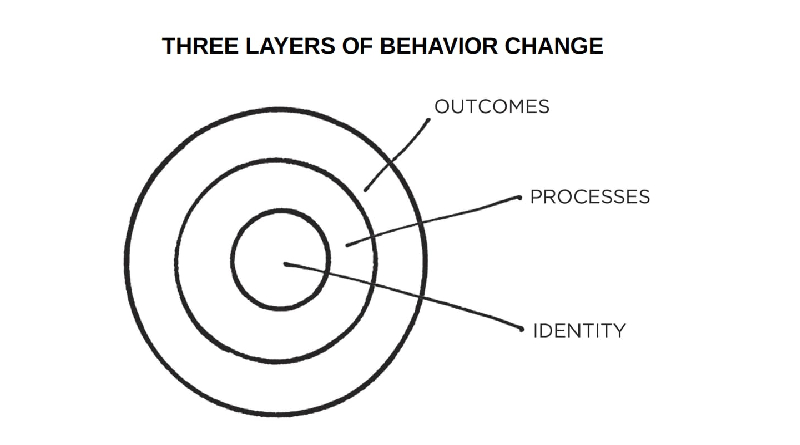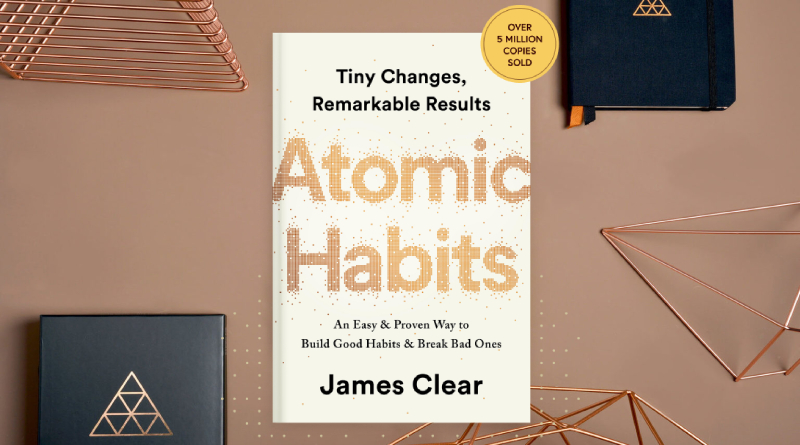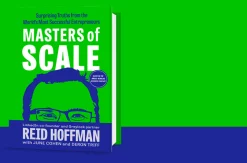Atomic Habits: An Easy & Proven Way to Build Good Habits & Break Bad Ones by James Clear, Book Review and Summary
About The Book:
The #1 New York Times bestseller. Over 2 million copies sold!
Tiny Changes, Remarkable Results
No matter your goals, Atomic Habits offers a proven framework for improving–every day. James Clear, one of the world’s leading experts on habit formation, reveals practical strategies that will teach you exactly how to form good habits, break bad ones, and master the tiny behaviors that lead to remarkable results.
If you’re having trouble changing your habits, the problem isn’t you. The problem is your system. Bad habits repeat themselves again and again not because you don’t want to change, but because you have the wrong system for change. You do not rise to the level of your goals. You fall to the level of your systems. Here, you’ll get a proven system that can take you to new heights.
Clear is known for his ability to distill complex topics into simple behaviors that can be easily applied to daily life and work. Here, he draws on the most proven ideas from biology, psychology, and neuroscience to create an easy-to-understand guide for making good habits inevitable and bad habits impossible. Along the way, readers will be inspired and entertained with true stories from Olympic gold medalists, award-winning artists, business leaders, life-saving physicians, and star comedians who have used the science of small habits to master their craft and vault to the top of their field.
Learn how to:
• make time for new habits (even when life gets crazy);
• overcome a lack of motivation and willpower;
• design your environment to make success easier;
• get back on track when you fall off course;
…and much more.
Atomic Habits will reshape the way you think about progress and success, and give you the tools and strategies you need to transform your habits–whether you are a team looking to win a championship, an organization hoping to redefine an industry, or simply an individual who wishes to quit smoking, lose weight, reduce stress, or achieve any other goal.
Editorial Reviews:
Wall Street Journal bestseller
USA Today bestseller
Publisher’s Weekly bestseller
One of Fast Company’s 7 Best Business Books of 2018
One of Business Insider’s Best Self-Help Books of 2018
“A supremely practical and useful book. James Clear distills the most fundamental information about habit formation, so you can accomplish more by focusing on less.”
-Mark Manson, #1 New York Times best-selling author of The Subtle Art of Not Giving a F*ck
“James Clear has spent years honing the art and studying the science of habits. This engaging, hands-on book is the guide you need to break bad routines and make good ones.”
-Adam Grant, New York Times best-selling author of Originals, Give and Take, and Option B with Sheryl Sandberg
“A special book that will change how you approach your day and live your life.”
-Ryan Holiday, bestselling author of The Obstacle is the Way and Ego is the Enemy
“As a physician attempting to help my patients build healthy habits to decrease and reverse chronic disease, Atomic Habits is the playbook I have been searching for. Not only does the book offer actionable items I can teach my patients, I can refer them to read and implement the ideas themselves. The format is powerful and simple. This should be taught in all medical schools.”
-Laurie Marbas, MD, United States Air Force veteran
“Atomic Habits was a great read. I learned a lot and think it’ll be helpful to a lot of people.”
—Gayle King, co-anchor of CBS This Morning and editor-at-large for O, The Oprah Magazine
“Useful new book”
–Wall Street Journal
“In Atomic Habits, Clear will show you how to overcome a lack of motivation, change your environment to encourage success, and make time for new (and better) habits.
–Glamour.com
“Atomic Habits is a great book for anyone who is frustrated with the way they can’t seem to kick that one (or two dozen) bad habit(s) and wants to finally achieve health, fitness, financial freedom, great relationships, and a good life.”
–Medium.com
“Excellent. Well worth the read.”
–Benjamin Hardy, Inc.com
About The Author:
James Clear is a writer and speaker focused on habits, decision-making, and continuous improvement. He is the author of the New York Times bestseller, Atomic Habits. His work has appeared in Entrepreneur magazine, Time magazine, the New York Times, the Wall Street Journal, and on CBS This Morning.
His website, jamesclear.com, receives millions of visitors each month and hundreds of thousands subscribe to his popular email newsletter. He is a regular speaker at Fortune 500 companies and his work is used by coaches and players in the NFL, NBA, and MLB.
My Review:
Appearance:
Content:
Did You Know: (Book Articles)
2
How Your Habits Shape Your Identity (and Vice Versa)
WHY IS IT so easy to repeat bad habits and so hard to form good ones? Few things can have a more powerful impact on your life than improving your daily habits. And yet it is likely that this time next year you’ll be doing the same thing rather than something better. It often feels difficult to keep good habits going for more than a few days, even with sincere effort and the occasional burst of motivation.
Habits like exercise, meditation, journaling, and cooking are reasonable for a day or two and then become a hassle. However, once your habits are established, they seem to stick around forever—especially the unwanted ones. Despite our best intentions, unhealthy habits like eating junk food, watching too much television, procrastinating, and smoking can feel impossible to break.
Changing our habits is challenging for two reasons:
(1) we try to change the wrong thing and
(2) we try to change our habits in the wrong way.
In this chapter, I’ll address the first point. In the chapters that follow, I’ll answer the second. Our first mistake is that we try to change the wrong thing. To understand what I mean, consider that there are three levels at which change can occur. You can imagine them like the layers of an onion.

The first layer is changing your outcomes. This level is concerned with changing your results: losing weight, publishing a book, winning a championship. Most of the goals you set are associated with this level of change.
The second layer is changing your process. This level is concerned with changing your habits and systems: implementing a new routine at the gym, decluttering your desk for better workflow, developing a meditation practice. Most of the habits you build are associated with this level.
The third and deepest layer is changing your identity. This level is concerned with changing your beliefs: your worldview, your self-image, your judgments about yourself and others. Most of the beliefs, assumptions, and biases you hold are associated with this level.
Outcomes are about what you get. Processes are about what you do. Identity is about what you believe. When it comes to building habits that last—when it comes to building a system of 1 percent improvements—the problem is not that one level is “better” or “worse” than another. All levels of change are useful in their own way. The problem is the direction of change.
Many people begin the process of changing their habits by focusing on what they want to achieve. This leads us to outcome-based habits. The alternative is to build identity-based habits. With this approach, we start by focusing on who we wish to become.
8
How to Make a Habit Irresistible
IN THE 1940S, a Dutch scientist named Niko Tinbergen performed a series of experiments that transformed our understanding of what motivates us. Tinbergen—who eventually won a Nobel Prize for his work—was investigating herring gulls, the gray and white birds often seen flying along the seashores of North America.
Adult herring gulls have a small red dot on their beak, and Tinbergen noticed that newly hatched chicks would peck this spot whenever they wanted food. To begin one experiment, he created a collection of fake cardboard beaks, just a head without a body. When the parents had flown away, he went over to the nest and offered these dummy beaks to the chicks. The beaks were obvious fakes, and he assumed the baby birds would reject them altogether.
However, when the tiny gulls saw the red spot on the cardboard beak, they pecked away just as if it were attached to their own mother. They had a clear preference for those red spots—as if they had been genetically programmed at birth. Soon Tinbergen discovered that the bigger the red spot, the faster the chicks pecked. Eventually, he created a beak with three large red dots on it. When he placed it over the nest, the baby birds went crazy with delight. They pecked at the little red patches as if it was the greatest beak they had ever seen.
Tinbergen and his colleagues discovered similar behavior in other animals. For example, the greylag goose is a ground-nesting bird. Occasionally, as the mother moves around on the nest, one of the eggs will roll out and settle on the grass nearby. Whenever this happens, the goose will waddle over to the egg and use its beak and neck to pull it back into the nest.
Tinbergen discovered that the goose will pull any nearby round object, such as a billiard ball or a lightbulb, back into the nest. The bigger the object, the greater their response. One goose even made a tremendous effort to roll a volleyball back and sit on top. Like the baby gulls automatically pecking at red dots, the greylag goose was following an instinctive rule: When I see a round object nearby, I must roll it back into the nest. The bigger the round object, the harder I should try to get it.
It’s like the brain of each animal is preloaded with certain rules for behavior, and when it comes across an exaggerated version of that rule, it lights up like a Christmas tree. Scientists refer to these exaggerated cues as supernormal stimuli. A supernormal stimulus is a heightened version of reality—like a beak with three red dots or an egg the size of a volleyball—and it elicits a stronger response than usual.
Humans are also prone to fall for exaggerated versions of reality. Junk food, for example, drives our reward systems into a frenzy. After spending hundreds of thousands of years hunting and foraging for food in the wild, the human brain has evolved to place a high value on salt, sugar, and fat. Such foods are often calorie-dense and they were quite rare when our ancient ancestors were roaming the savannah. When you don’t know where your next meal is coming from, eating as much as possible is an excellent strategy for survival.
Today, however, we live in a calorie-rich environment. Food is abundant, but your brain continues to crave it like it is scarce. Placing a high value on salt, sugar, and fat is no longer advantageous to our health, but the craving persists because the brain’s reward centers have not changed for approximately fifty thousand years. The modern food industry relies on stretching our Paleolithic instincts beyond their evolutionary purpose.
A primary goal of food science is to create products that are more attractive to consumers. Nearly every food in a bag, box, or jar has been enhanced in some way, if only with additional flavoring. Companies spend millions of dollars to discover the most satisfying level of crunch in a potato chip or the perfect amount of fizz in a soda. Entire departments are dedicated to optimizing how a product feels in your mouth—a quality known as orosensation. French fries, for example, are a potent combination—golden brown and crunchy on the outside, light and smooth on the inside.
18
The Truth About Talent (When Genes Matter and When They Don’t)
MANY PEOPLE ARE familiar with Michael Phelps, who is widely considered to be one of the greatest athletes in history. Phelps has won more Olympic medals not only than any swimmer but also more than any Olympian in any sport.
Fewer people know the name Hicham El Guerrouj, but he was a fantastic athlete in his own right. El Guerrouj is a Moroccan runner who holds two Olympic gold medals and is one of the greatest middledistance runners of all time. For many years, he held the world record in the mile, 1,500-meter, and 2,000-meter races. At the Olympic Games in Athens, Greece, in 2004, he won gold in the 1,500-meter and 5,000-meter races.
These two athletes are wildly different in many ways. (For starters, one competed on land and the other in water.) But most notably, they differ significantly in height. El Guerrouj is five feet, nine inches tall. Phelps is six feet, four inches tall. Despite this seven-inch difference in height, the two men are identical in one respect: Michael Phelps and Hicham El Guerrouj wear the same length inseam on their pants.
How is this possible? Phelps has relatively short legs for his height and a very long torso, the perfect build for swimming. El Guerrouj has incredibly long legs and a short upper body, an ideal frame for distance running.
Now, imagine if these world-class athletes were to switch sports. Given his remarkable athleticism, could Michael Phelps become an Olympic-caliber distance runner with enough training? It’s unlikely. At peak fitness, Phelps weighed 194 pounds, which is 40 percent heavier than El Guerrouj, who competed at an ultralight 138 pounds. Taller runners are heavier runners, and every extra pound is a curse when it comes to distance running. Against elite competition, Phelps would be doomed from the start.
I always write my reviews on Amazon, 3ee, Goodreads, LibraryThing, and Social Media such as Facebook, Instagram, Twitter, Linked In, Telegram.
If you also have read this book, please share your review below, we greatly appreciate your comment, and let’s talk about it!



